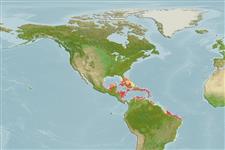Environment: milieu / climate zone / depth range / distribution range
Sinh thái học
Biển Cùng sống ở rạn san hô; Mức độ sâu 3 - 15 m (Ref. 9710). Tropical
Western Central Atlantic: there are two color morphs that may be genetically different. Form 1 (brown dorsally and yellow ventrally, the brown pigment may extend farther ventrally than the blue pigment in form 2, leaving only the ventral surface yellow ) is found in Central America. Form 2 (blue or brown dorsally and yellow ventrally) is found in the Virgin Islands and the Greater Antilles. The only record from the Lesser Antilles is from Dominica. Although one specimen has been recorded from Florida (UMML 7085, specimen missing) this locality may be in error because no other specimen has been sighted in Florida apart from that record.
Bộ gần gũi / Khối lượng (Trọng lượng) / Age
Maturity: Lm ? range ? - ? cm
Max length : 13.0 cm TL con đực/không giới tính; (Ref. 9710)
Form 1: divided into brown dorsally and yellow ventrally (margin between the two colors usually located at the midline, but the brown may sometimes extend lower leaving only the belly yellow); dorsal fin brown, all other fins yellow to yellowish brown; face brownish yellow; sometimes with a small black spot occurring at the dorsal region of the caudal peduncle. Form 2: divided into blue or brown dorsally (the blue pigment covering a much smaller area than the brown pigment in form 1, restricted to the region of the back and not extending to the midline).
A solitary species (Ref. 26340) inhabiting rocky and coral reefs (Ref. 9710). Feeds on crustaceans (primarily shrimps) (Ref. 26180).
Life cycle and mating behavior
Chín muồi sinh dục | Sự tái sinh sản | Đẻ trứng | Các trứng | Sự sinh sản | Ấu trùng
Domeier, M.L., 1994. Speciation in the serranid fish Hypoplectrus. Bull. Mar. Sci. 54(1):103-141. (Ref. 26407)
IUCN Red List Status (Ref. 130435)
Threat to humans
Harmless
Human uses
Các nghề cá:
Thêm thông tin
Các tài liệu tham khảoNuôi trồng thủy sảnTổng quan nuôi trồng thủy sảnCác giốngDi truyềnElectrophoresesDi sảnCác bệnhChế biếnNutrientsMass conversion
Các công cụ
Special reports
Download XML
Các nguồn internet
Estimates based on models
Preferred temperature (Ref.
123201): 26.7 - 28.3, mean 27.6 °C (based on 448 cells).
Phylogenetic diversity index (Ref.
82804): PD
50 = 0.5000 [Uniqueness, from 0.5 = low to 2.0 = high].
Bayesian length-weight: a=0.01778 (0.00680 - 0.04650), b=3.03 (2.80 - 3.26), in cm total length, based on LWR estimates for this (Sub)family-body shape (Ref.
93245).
Mức dinh dưỡng (Ref.
69278): 3.6 ±0.59 se; based on food items.
Thích nghi nhanh (Ref.
120179): Chiêù cao, thời gian nhân đôi của chủng quần tối thiểu là dưới 15 tháng (Preliminary K or Fecundity.).
Fishing Vulnerability (Ref.
59153): Low vulnerability (10 of 100).
Nutrients (Ref.
124155): Calcium = 90 [50, 174] mg/100g; Iron = 0.698 [0.369, 1.316] mg/100g; Protein = 18 [16, 20] %; Omega3 = 0.122 [0.071, 0.205] g/100g; Selenium = 22.2 [12.2, 45.1] μg/100g; VitaminA = 93.3 [24.9, 398.6] μg/100g; Zinc = 1.43 [0.91, 2.18] mg/100g (wet weight);
